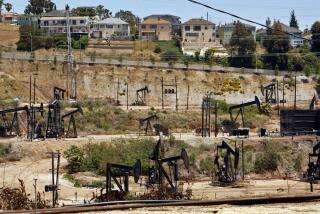Life on the Rig : Careers: Men who labor on the 2,300-plus oil wells in Ventura County enjoy the outdoor work, high pay and camaraderie of their jobs.
Grease, dirt and sweat coat the men who work on the oil wells that cut a mile and a half into the Rincon cliffs northwest of Ventura.
But they say they love every minute of it--the high pay, the ever-changing work and the staggering view of the Channel Islands on clear days.
Oil rig supervisor Toby Thrower figures he and his three-man crew have been “pushing rig” in California for a combined total of 80 years.
In his youth, Thrower switched from handling oil pipe in the Oklahoma oil fields to assembling telephone equipment for Western Electric in Oklahoma City.
After five years, sick of being stuck indoors and bored with repetitive assembly-line work, Thrower came to California to work in oil fields again.
Now 52, with grin lines etched into his face by the work and the sun, Thrower says he won’t leave until he has to retire.
“As long as you’ve got two pieces of metal rubbing together and you’ve got to have something to lubricate them, I’ll have something to do,” Thrower said. “It’s a lifetime occupation.”
Thrower’s crew works for Pride Petroleum Service of Ventura, one of six companies maintaining more than 2,300 oil wells in Ventura County. The wells produced 6.5 million barrels of oil last year.
Last week, the crew drove a mobile, truck-mounted rig into position near a well in the Padre Canyon field run by Santa Fe Energy Resources Inc. There, mineral deposits clogging the well had forced the oil company to stop the pump’s rocking-horse action and call in the maintenance crew.
As traffic whispered past on the Pacific Coast Highway hundreds of feet below, the crew disconnected the pump from the wellhead, then flicked a switch to set the rig in motion.
Pushed by hydraulic rams, the rig assembled itself. Its superstructure of steel bars jackknifed upward, two sections unfolding from the truck’s back to form a single derrick that towered 92 feet over the wellhead.
“You’ve got to work closely, or not at all,” said Jack Morrison, 46, operations manager for Pride Petroleum.
“You work together, you eat lunch together, you go back and forth to work together, sometimes one and a half hours both ways. You can’t bring grudges to work in this type of atmosphere,” he said, watching the crew begin pulling 8,200 feet of tubing out of the well in 60-foot sections.
The crew worked confidently, swiftly.
Dave Brewer, 35, acted as the driller, running the hoist that pulled the mile-and-a-half-long tube full of ground water up out of the well. Most wells in this area deliver about 90% water and 10% oil, Morrison said.
As each threaded joint in the tubing rose into view, Brewer stopped the hoist so that floor man Lyle Bodle, 23, could disconnect the sections of tubing.
Bodle whacked each joint loose with a sledgehammer, then shoved a massive hydraulic wrench called the tongs onto the joint to finish unscrewing the sections’ threaded ends.
As each tubing section came free, its cargo of water spurted from the joint, dousing Bodle, who grinned and hopped in the cold spray, then pulled the tongs away.
Brewer then hoisted the pipe clear to stand its bottom end in a storage area while derrick man Brian Radford, 35, shoved its top end into a rack nearly 60 feet above.
During a break, Radford’s eyes bugged out as he remembered the first time he looked down while tallying tubing high on the derrick.
“I was like, ‘Whoa, I don’t like this,’ ” he said, oil smearing his smile. “But now, I wouldn’t feel comfortable if I wasn’t up there.”
During 40-hour weeks, unskilled laborers start out earning $11 an hour, while drillers can earn $13 to $16 an hour, Morrison said.
Supervisors can earn from $3,500 to $4,500 a month for the non-union work, and everyone can earn bonuses of $100 for every 90 days worked without accident, he said.
“It’s hard work, but it’s fun--heck, yeah!” Bodle said while the sun dried his soaked work shirt during a break.
“You’ve got to know the tricks of the trade and the secrets,” Bodle said. “You can work 10 years and not do the same thing twice. A lot goes on down-hole.”
What went on in this well happens to most, Thrower said.
Minerals in the water and oil flowing into the well bottom had built up on a steel sleeve known as the casing, clogging perforations in the casing that allow the fluid to be sucked into the well.
This called for an “acid job.”
The crew’s job was to pull out the tubing and pump acid into the well’s bottom, where it would eat away the mineral deposits.
Then they would replace the tubing, reinsert into it an 8,200-foot-long steel rod with a system of valves at its bottom that pumps oil, and reattach the rod to the pump’s horse-head.
When it was switched on again, the up-and-down motion of the pump high on the Rincon would move the valve system at the bottom of the well, pulling up a column of water and oil.
And that liquid would be pumped through pipes that wind down out of the hills to a separating facility near Seacliff, where the oil would be stored and the water injected back into the oil field, Morrison said.
Brewer said he has been around oil rigs since age 5, when his uncles, aunts and grandfathers used to show him where they worked.
“They got me involved in it,” Brewer said as he bit an apple during his break.
Once in, he stayed.
“It’s outdoors, I’m not confined in a building,” Brewer said, gazing at the oil roads that snaked between rocking well pumps, up to the tan crowns of the Rincon Mountains. “What could be better? You’re out here having a picnic with your buddies every day and you get to do this for a living.”
More to Read
Sign up for Essential California
The most important California stories and recommendations in your inbox every morning.
You may occasionally receive promotional content from the Los Angeles Times.










